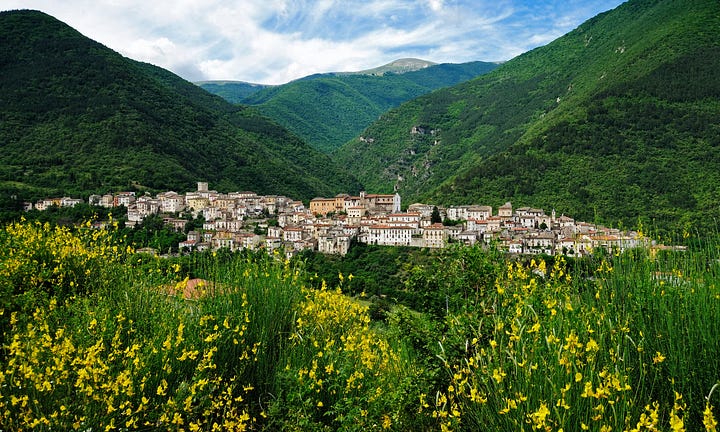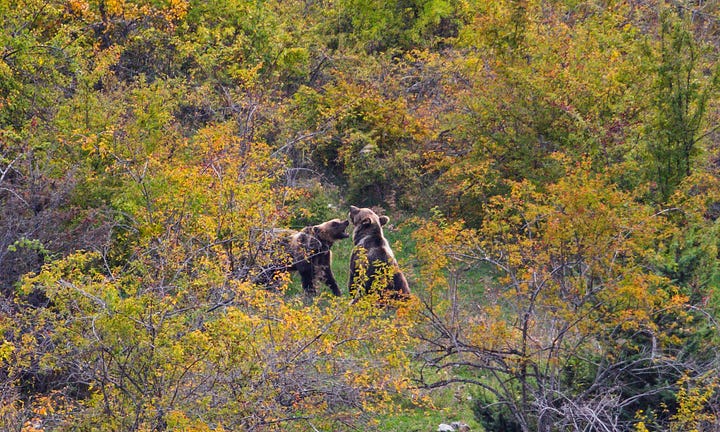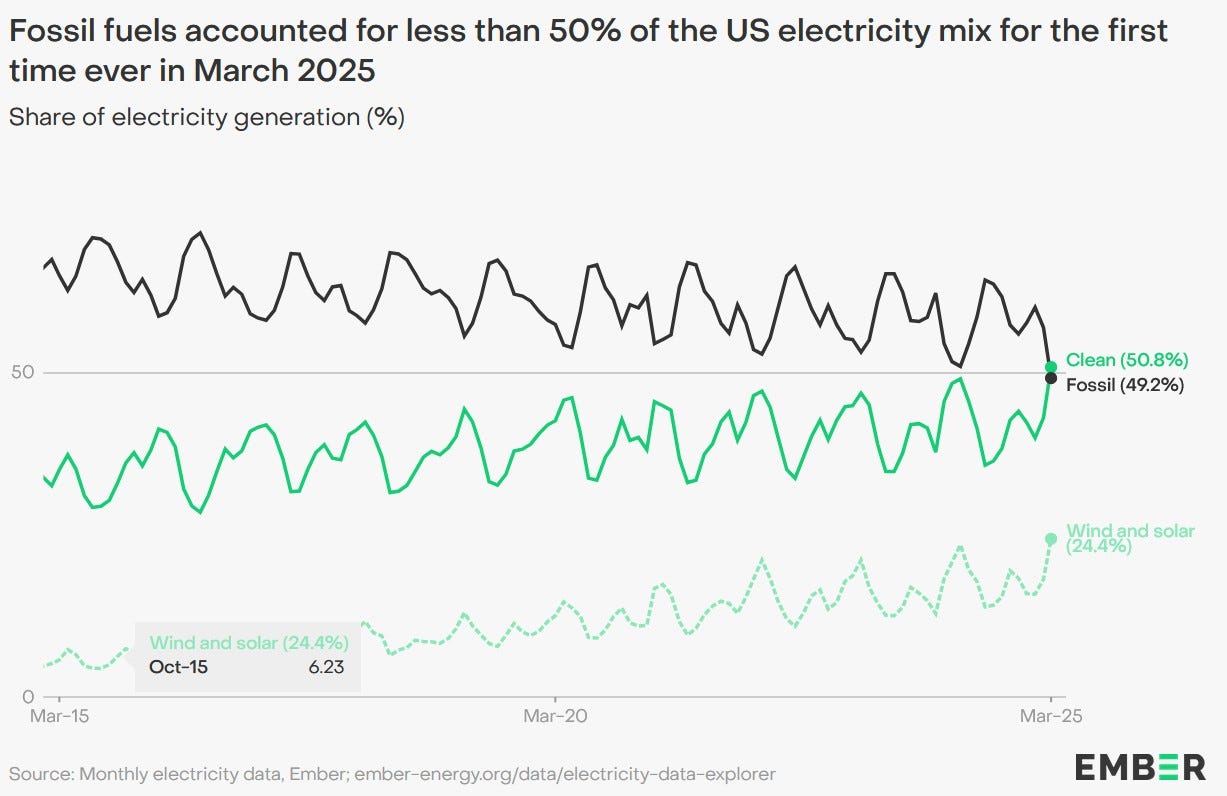The Weekly Anthropocene, April 16 2025
40.9% clean electricity worldwide, red-tailed amazon parrot recovery, Yazidi grassroots reforestation, electric flying taxis, Italy's bear town, e-tricycles in Zimbabwe, the Colossal wolves, and more!
The Big Picture

The leading Ember energy think tank reports that the historically fast acceleration of solar power worldwide has pushed all low-carbon energy sources (renewables plus nuclear) to provide 40.9% of all of human civilization’s electricity in 2024, crossing 40% for the first time. Critically, even though the world’s demand for electricity keeps rising, clean energy growth is now consistently outpacing demand growth, meeting growing needs while cutting into incumbent fossil fuels’ market share. Spectacular!
“Solar power has become the engine of the global energy transition…
Paired with battery storage, solar is set to be an unstoppable force. As the fastest-growing and largest source of new electricity, it is critical in meeting the world’s ever-increasing demand for electricity.”
— Phil MacDonald, Ember
A new report calculates that 703 GW (703,000 MW) of solar panels were shipped around the world in 2024 - while average prices fell by 33% from 2023. Dawn breaks!
Brazil


The red-tailed amazon parrot1 (Amazona brasiliensis) was driven to near-extinction by the end of the 20th century, with only about 5,000 individuals surviving loss of habitat in its homeland of southeastern coastal Brazil combined with the depredations of the pet trade. In 2003, conservationists began installing tailor-made artificial nest boxes at the largest surviving communal roost on Rasa Island, providing safe hollows where large guanandi trees had become scarce due to logging. There are now over 120 nest boxes across the parrots’ range, and their population has soared to over 9,000. Another great example of Anthropocene-ready proactive conservation!
Iraq
The Yazidi (or Yezidi) religious minority of northern Iraq made international news when they were brutally persecuted and enslaved by the ISIS terrorist group in 2014. Now, Yazidi women who survived the genocidal atrocities are running their own grassroots social and environmental group, Clean Green. They’re already planted over 2,000 trees of hardy and useful species like orange, olive, and Aleppo pine in and around Khanke town, reducing dust and providing shelter from winds. Great work!
Solar power development is rapidly accelerating across the sun-drenched lands of Iraq! The Iraqi government just signed one MOU with an American company to build a 3 GW (3,000 MW) solar farm, plus another deal with French and Qatari companies to build another 1.25 GW solar farm. Iraq’s Central Bank announced that they will offer low-interest loans for individuals and businesses to install solar panels, and 16 more companies were recently accredited to deploy such rooftop solar systems. Excellent!
China
Chinese regulators have granted approval for two companies to operate pilotless eVTOL human passenger-carrying drones — essentially autonomous electric flying taxis. One of those companies, EHang, has also recently flown their EH216-S craft in Mexico. We may get a wave of flying Chinese EVs right on the heels of the current wave of ground-level EVs — transforming world urban mobility! Wow.
The Jinneng Group has started construction on a planned 5 GW (5,000 MW) of new solar capacity consisting of three new solar farms in the Datong coal mining subsidence zone in northern Shanxi Province. The new solar farms will be backed up by 3.4 GWh of energy storage and will feed into an ultra-high-voltage power line, and the project also includes ecological remediation for about 150 km2 of subsided land.
A giant new 1.6 GW (1,600 MW) solar farm was recently switched on in the Ulan Buh Desert near Bayannur in Inner Mongolia, China. It covers about 2,973 hectares. Notably, the space between the rows of solar panels is now used for large-scale cultivation of sand-fixing plants to fight desertification and soil erosion. Great work!
Water hyacinth (Eichhornia crassipes) is a very fast-growing aquatic flowering plant that has become an invasive species in wetlands around the world - but it's also been found to help clean up pollutants ranging from farm runoff to heavy metals. Now, a new study from Chinese researchers has discovered that water hyacinth plants are excellent at removing microplastics from surrounding waters. The study found that the hyacinth could absorb 78% of a high microplastics concentration from water into their tissues in just 5 days. The phytoremediation potential is vast. Fascinating!
A new paper analyzing years of data from the BEF-China projects, the world’s largest tree-planting experiments, concluded that more species-diverse forests provide more of a climate buffering effect. A planting with 24 species reduced summer heat by 4.4°C more than a monoculture — while also achieving higher wood production and carbon storage. An immediately applicable handy hint for foresters worldwide!
The governments of China and France recently issued a new joint statement on the importance and urgency of action to fight climate change and protect biodiversity and ecosystems. A sign of the rapidly changing eco-geopolitics of Anthropocene Earth!
Italy


The medieval-built town of Pettorano sul Gizio in the Abruzzo region of Italy has created a local economic boom by welcoming the presence of brown bears (Ursus arctos, known in the U.S. as grizzly bears) in the rewilding Apennine Mountains around them. They’ve built over 100 electric fences and deployed bear-proof garbage bins to reduce formerly-widespread human-bear conflict, with no damages reported since 2020. Much of rural Italy is experiencing rapid population decline due to aging demographics, but by rebuilding itself around coexistence with bears, Pettorano sul Gizio has attracted many new residents and businesses as a burgeoning ecotourism hotspot. Another inspiring case study from the epic great rewilding of Europe!
Zimbabwe
As solar energy gains momentum across Africa, a multitude of new local examples of cleantech-powered socioeconomic progress are popping up throughout the continent. In Zimbabwe, the Mobility for Africa project is leasing Hamba model electric tricycles, powered by hot-swappable batteries charged at solar-powered stations. 70% of beneficiaries are women, with an estimated 300 women across rural Zimbabwe now using their e-trikes to carry crops to market, patients to hospitals, building materials to worksites, water to households, and more. Excellent work!
United States
These are dark and scary times for the U.S.A, as the current regime claims dictatorial powers and spits on the rule of law amid self-inflicted economic chaos. But unless and until this writer is illegally shipped to a Salvadoran prison camp, this newsletter will keep sharing the stories of innovative Americans working to build a better future2.
In a historic milestone, renewables plus nuclear produced 51% of America’s electricity in March 2025, while all fossil fuels combined produced a record-low 49%. What was deemed an impossible dream just a few years ago is now a barely-noticed real achievement - despite political nonsense, economics keep driving progress!
“Wind and solar power are pushing fossil fuels out of the mix.
The reality on the ground is not one of a return to fossil fuels in the US, it’s the continued growth of solar and wind power that will be the dominant driver of electricity generation growth in the US.”
— Nicholas Fulghum, Ember
Like the rest of the economy, the hard-won U.S. clean energy manufacturing sector built under Biden is reeling from the imbecilic whims of the current regime, with $7.73 billion in planned clean energy investment canceled in the first quarter of 2025, mostly in red states. One company planning a battery component factory in Georgia decided to relocate production to the more politically stable China. However, there are still several bright spots where U.S. clean energy innovators are keeping at it!
Indian solar company Waaree Energies announced plans to expand its solar manufacturing in Texas, adding 1.6 GW of capacity to reach 3.2 GW.
The U.S. startup Aetherflux has raised $50 million in funding for its space-based solar power plans. They plan to use that to send a satellite to orbit bearing their tech, and hope to conduct their first demonstration of laser-beaming power from low-Earth orbit to a ground station (likely to be built on U.S. military land) as soon as 2026.
SorbiForce, a Ukrainian startup now working in Arizona, has developed a revolutionary new “organic battery” made with just carbon, water, salt, and agricultural waste — four very low-cost materials. They’re currently raising funding and planning pilot projects!
Google is working with researchers at the Wild Dolphin Project to develop DolphinGemma, an LLM (generative AI model) designed to help translate dolphin communication. It can run on Pixel phones in the field, can predict “next most likely” dolphin sounds similarly to how many AI predict English words, and is set to be shared as an open model in summer 2025. Amazing work!
Conservation X Labs, a pioneering U.S. biodiversity protection tech accelerator, has awarded $50,000 each to the 12 finalist teams in their Fire Grand Challenge, working on new methods to prevent, fight, and recover from wildfires. There’s a bunch of fascinating new innovations here! Skyward plans to use AI to identify high-risk storms followed by cloud-seeding to actively prevent fire-causing lightning strikes. The Coldfire Project wants to use native fungi to accelerate decay of burnable dead wood on forest floors. Wildfire Robotics has invented Firewall, a giant nozzle-bearing snake-like robot to surround, contain, and spray water on incipient wildfires. Flash Forest works to scale up reforestation by firing seed pods from drones. And FireSwarm Solutions plans to use fleets of ultra-heavy-lift drones (each carrying up to 400 kg!) to automate wildfire response. Epic work!
American researchers have developed a film made of silica and hafnium dioxide that is excellent at emitting infrared radiation (that is, heat) making it able to rapidly cool surfaces it’s applied to — potentially including buildings and outdoor spaces under film tents — without using electricity. A welcome new tool for a warming world!
Construction has begun on Equinox Wind 1, an epic 810 MW (0.81 GW) offshore wind farm in New York State waters that was permitted under the Biden Administration. This amazing grid-decarbonizing and biodiversity-boosting artificial reef is planned to power 500,000 New York homes by 2027! Spectacular work.
Biotech startup Colossal Biosciences made headlines with its claim to have achieved successful de-extinction of the dire wolf. While it’s arguably more of a designer gray wolf with twenty CRISPR gene-edits for traits including larger skulls and white fur, this is still an extraordinary and inspiring scientific achievement — and a great strategy to build up public support and investor funding for much-needed megafauna rewilding (see my interview on this)! Colossal has also recently produced four new individuals of the critically endangered red wolf using techniques developed during dire wolf research, exemplifying the likely immense “ripple effect” benefits of de-extinction biotech innovation for conservation of existing wildlife. This writer hopes to see genetic fascimiles of thylacines, passenger pigeons, woolly mammoths (maybe by 2028!), and more enriching Earth’s ecosystems in the near future!
The term “amazon” here is a taxonomic description for a related group of parrots in the genus Amazona, many of which don’t actually live in the Amazon Rainforest.
I’ve been thinking lately about parallels between 2020s America and the court dramas of Europe’s absolutist monarchs in the 1600s and 1700s. If there were online news in the late 1670s, the biggest stories by far would surely have been the latest crazy updates from royal circles - say L’Affaire des Poisons in the Versailles court of Louis XIV. But with the benefit of a few centuries of hindsight, we can now say that a much more resounding event in the late 1670s was how an eccentric self-taught Dutchman was messing around with shaped glass in his house in Delft, which would likely have seemed unutterably picayune to most contemporaries but resulted in Antonie van Leeuwenhoek inventing the microscope and becoming the first human to see microbial life. Centuries later, who poisoned who at Versailles is historical trivia, while the heirs of Leeuwenhoek have revolutionized science and saved millions of human lives. We too live in such an age, with fascinating potential for scientific and socioeconomic advances struggling to be born despite the madness of kings. In this newsletter, I’m trying to identify and write about the van Leeuwenhoeks of the 2020s, the seeds of great ideas that can grow even during insane times.










So much great news from around the world! You truly amaze me with every issue. The dire wolf news was a bit of an eye roll for me, but I'm heartened to hear the company is also working on red wolf (news to me.) The de-extinction folks have some PR firms working in their favor but I think they have more convincing to do for skeptics, like me, as to why our ecosystems need things that have been gone for more than 10,000 years. I would love to see the passenger pigeon or thylacine return.
Love all this great solar news! Bloomberg's BNEF just wrote that you can't put tariffs on the sun or the wind. (Obviously you can put tariffs on panels, but once they're set up, they'll capture that sweet sweet sunlight for 20-30 years, unlike oil that you have to keep digging up since you light in on fire every time you use it!)